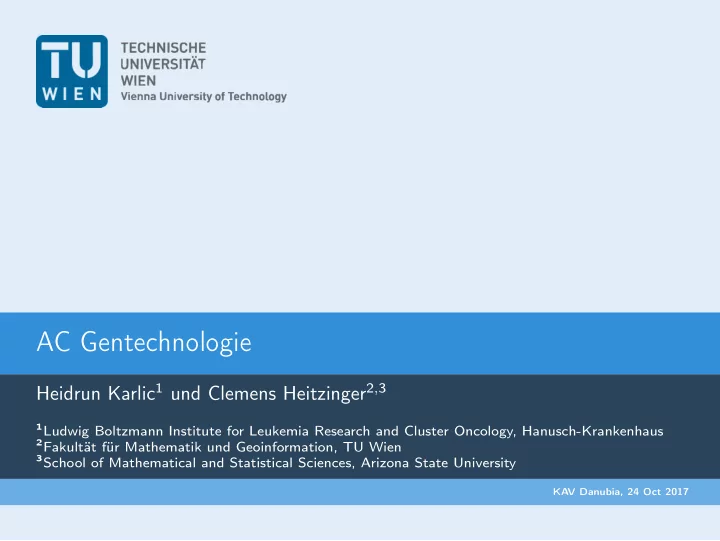

AC Gentechnologie Heidrun Karlic 1 und Clemens Heitzinger 2 , 3 1 Ludwig Boltzmann Institute for Leukemia Research and Cluster Oncology, Hanusch-Krankenhaus 2 Fakultät für Mathematik und Geoinformation, TU Wien 3 School of Mathematical and Statistical Sciences, Arizona State University KAV Danubia, 24 Oct 2017
Nanopores as sensors Nanopores can be used as molecular sensors using the principle of a Coulter counter. Applications include ◮ next-generation DNA sequencing (Oxford Nanopore Technologies), [Quick et al. Real-time, portable genome sequencing for Ebola surveillance. Nature, 530 :228–232, 2016.] ◮ marker-free detection of single molecules. [Burns et al. A biomimetic DNA-based channel for the ligand-controlled transport of charged molecular cargo across a biological membrane. Nature http: //www2.technologyreview.com/article/427677/ Nanotechnology, 6 :152–156, 2016.] nanopore-sequencing/ 2 of 14
Movie: nanopore sequencing Movie 3 of 14
Nanopore sensors Reservoir Cargo molecule Diffusion Association/ dissociation Receptor Applied potential Outflow 4 of 14
The basic continuum model: the drift-diffusion-Stokes-Poisson system Drift-diffusion equations for ionic transport, (Navier-)Stokes equations for water transport, Poisson equation for electrostatic interactions. −∇ · ( A ∇ V ) = q ( c + − c − + c + m − c − m ) , ∇ · J − = 0 , ∇ · J + = 0 , J − = q ( D − ∇ c − − µ − c − ∇ V − c − v ) , J + = q ( − D + ∇ c + − µ + c + ∇ V + c + v ) , m + c + − c − m − c − ) ∇ V , ∇ P = η ∆ v − q ( c + ∇ · v = 0 . We use 2D and 3D FE calculations to solve this system. 5 of 14
The force on the target molecules F el ( x ) 2 −10.8 Force consists of electrostatic and drag 0 −11.2 contributions: −11.6 −2 F ( x ) = F el ( x ) + F drag ( x ) , −12.0 Z coordinate [nm] −12.4 −4 � F el ( x ) = E ρ, −12.8 M −6 −13.2 � � � ∇ u + ∇ u ⊤ � � F drag ( x ) = + pI n · − η . −13.6 −8 ∂ M −14.0 −10 −4 −2 0 2 4 X coordinate [nm] 6 of 14
The force on the target molecules F drag ( x ) 2 −12.0 Force consists of electrostatic and drag 0 −12.5 contributions: −13.0 −2 F ( x ) = F el ( x ) + F drag ( x ) , −13.5 Z coordinate [nm] −14.0 −4 � F el ( x ) = E ρ, −14.5 M −6 −15.0 � � � ∇ u + ∇ u ⊤ � � F drag ( x ) = + pI n · − η . −15.5 −8 ∂ M −16.0 −10 −4 −2 0 2 4 X coordinate [nm] 6 of 14
DNA-origami nanopore: the force acting on the target molecules Velocity of liquid Electrostatic and drag force 7 of 14
Validation by comparison with experimental data 150 100 50 Current [pA] 0 − 50 PNPS 0 . 0 mC/m 2 PNPS − 40 . 0 mC/m 2 − 100 PNPS − 80 . 0 mC/m 2 ref. − 150 − 100 − 50 0 50 100 Voltage Bias [mV] 8 of 14
Movie: nanopore as single-molecule sensor Movie 9 of 14
Continuum formulation of exit-time problem From the Langevin equation √ d x 2 D ξ t + D d t = kT F ( x ) , the backward Fokker-Planck equation ∂ t p = ∇ · ( D ∇ p ) + D kT F · ∇ p can be derived. Here p ( x , t ) is the probability that particle has exited. 10 of 14
Exit-time problem: continuum solution Probability of successful exit: start point z nanometers above the pore and translocate pore within [ 0 , t ] without hitting boundary far away above pore. t = 0.00474890026424 [s] 1.0 0.8 0.6 p(x, t) 0.4 0.2 0.0 0 50 100 150 z [nm] Probability calculated here by solving the backward Fokker-Planck equation with Dirichlet boundary condition (1 means success, 0 means failure) and zero Neumann boundary conditions everywhere else. 11 of 14
Ausblick Technologischer Fortschritt in der Gentechnologie betrifft mehrere Schritte: ◮ Lesen (d.h. Sequenzieren): seit Jahrzehnten möglich, wird noch billiger werden ◮ Verstehen (Zusammenhang Genotyp-Phänotyp): daran wird gearbeitet, z.B. im GTEx-Projekt (genotype-tissue expression) ◮ Editieren: seit kurzem möglich, z.B. CRISPR ◮ Schreiben (d.h. Gensynthese): das nächste Ziel 12 of 14
Ethische Fragen ◮ Für Fortschritte in der personalisierten Medizin ist es notwendig, große (anonymisierte) Datenmenge (inkl. DNA-Sequenzen) zusammenzuführen und auszuwerten. Soll dafür die Zustimmung der Patienten notwendig sein? Wem gehören die Daten? ◮ Die Kosten mancher Therapien werden substantiell sein. Wird man sich die Kosten leisten können? Wer wird bezahlen? ◮ Durch Schreiben synthetischer Gene wird man neue Organismen erschaffen können. Soll das Editieren und Schreiben von Genen erlaubt sein? In welchen Fällen und für welche Organismen soll es erlaubt sein? 13 of 14
Danke für Eure Aufmerksamkeit! Fragen? Clemens.Heitzinger@gmail.com http:/ /Clemens.Heitzinger.name/ HeidrunKarlic@gmail.com http:/ /drkarlic.com 14 of 14
Recommend
More recommend